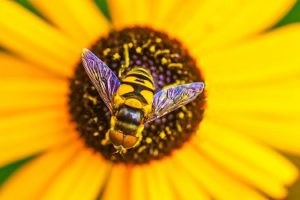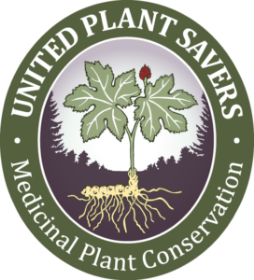By Jeanne Ruczhak-Eckman
 “If you build it, he will come,” says a voice to Kevin Costner in the 1989 hit movie Field of Dreams. The same is true for the bees and other pollinators. If you plant the right plants, the bees and butterflies and other beneficial insects will in turn come.
“If you build it, he will come,” says a voice to Kevin Costner in the 1989 hit movie Field of Dreams. The same is true for the bees and other pollinators. If you plant the right plants, the bees and butterflies and other beneficial insects will in turn come.
Bees love thyme. After you picked the leaves for use in your kitchen, let the herb continue to grow. The bees will appreciate the blooms. Other herbs that are known to attract bees are: borage, chives, cilantro, mint, oregano, rosemary, and sage.
Borage grows about 18” tall with a spread of 12”-24”. The leaves are used in salads and lemonade. Bees are attracted to the flowers of this annual herb. There are a couple choices when it comes to chives, all of which are perennial. The leaves and the flowers are both edible. Sizes vary depending on which choice of chives.
Cilantro is used with fish and meats. The height ranges from 12” to 24” and the spread is 12”. Cilantro is our featured herb this quarter. See page 26 for more information on this annual herb.
Mints are great in teas, marinades, and desserts. This perennial includes spearmint, peppermint, and orange. There are a couple varieties of Oregano. The Cleopatra offers a spicy flavor. Common and Italian are good in Italian dishes and sauces. They are more sweet than the Greek variety, which has more of an earthy flavor. All varieties of oregano are perennials.
Rosemary and sage are also perennials, as is thyme. Rosemary is very fragrant. It is used with meats, Sage can be dried and used for crafts in addition to cooking.
So which flowers are inviting to bees?
Agastache, Asters, Bee Balm, Blanket Flower, Butterfly Weed, Catmint, Coneflower, Goldenrod, Joe Pye Weed, Penstemon, Rudbeckia, Salvia, Sedum, and Yarrow.
Agastache is a great border plant which attracts bees and hummingbirds, as well as other pollinators. This sun loving plant can tolerate heat and dry soil. Burpee offers a new variety of Agastache this year called Peachie Keen. The small tubular flowers are an apricot peach color.
Asters are a low spreading perennial used frequently in rock gardens or as a border. It flowers in late spring to mid summer.
Bee Balm, also known as Monarda, is a colorful sun loving perennial. Its flowers make great summer arrangements and cut flowers. There are many different varieties of the Monarda, including Bee’s Knees, a Burpee exclusive. Scarlet in color, the Bee’s Knees is simply captivating and can stand up to mildew.
Butterfly bushes grow from 2 feet to four feet depending on the variety so they are best normally in the back of border or bed. They love the sun and quickly attract butterflies and other pollinators.
Coneflower, known as Echinacea, are super easy to grow. They bloom summer to fall.
Penstemon loves the full sun. It blooms between early summer to late fall, depending on the variety. It likes its soil damp and is a flowerbed favorite.
Perovskia is in the mint family. Although there are 10 species, the Russian Sage variety is my favorite perennial. The silver stems are covered in lavender flowers which give off a deep relaxing aroma. They are super easy to care for and love the heat of the summer sun. this tall plant can grow up to four feet complements ornamental grasses.
Rudbeckia, or Goldstrum, is probably best known as Black Eyed Susan. This popular perennial blooms mid-summer to early fall. It complements sedums, perovskia, and ornamental grasses.
Salvia add color to borders and window boxes with their vibrant summer bloom. They love full sun and prefer a well-drained soil.
Sedum are heat tolerant perennials. They are at home in rock gardens and as bordering plants. Sedums are a summer bloom.
Yarrow is another mid-summer bloomer. This perennial loves full sun to mid-shade. They are drought tolerant and make a great border plant.
When planting, do so in clumps when possible. This attracts the bees and other pollinators more so than planting single plants. Another attraction for pollinators are nesting sites. A tree stump or felled branch can house most varieties of bees.
As you plant these flowers and herbs, remember your soil and maintenance plan. Avoid pesticide use. Consider your mulch. I prefer using hardwood over black. While the black mulch does make the colors of my flowerbed pop, I just hate the idea of the dye potentially running off into the ground and eventually the water tables.
This article originally was published in Spring 2017 Issue 2.
(C)2017-2020, Therapeutic Thymes, LLC

 Harrisburg, PA – The PA Department of Agriculture has issued guidance for volunteers and employees of community gardens to continue working, with precautions, in recognition of them being critical to the resiliency of local food systems in Pennsylvania. While this was issued from PA, it is helpful and relevant across the nation right now as we continue to live amid COVID-19.
Harrisburg, PA – The PA Department of Agriculture has issued guidance for volunteers and employees of community gardens to continue working, with precautions, in recognition of them being critical to the resiliency of local food systems in Pennsylvania. While this was issued from PA, it is helpful and relevant across the nation right now as we continue to live amid COVID-19.
 We’ve been having some hot, humid days lately and today is going to be another so, if your garden is not getting enough rain, be mindful to water it at least weekly. Veggies and herbs need an inch of water – by rain or irrigation – each week. Hot days, like these lately, they may want even more. While you’re outside remember to hydrate! You need water too, especially on these heat advisory days.
We’ve been having some hot, humid days lately and today is going to be another so, if your garden is not getting enough rain, be mindful to water it at least weekly. Veggies and herbs need an inch of water – by rain or irrigation – each week. Hot days, like these lately, they may want even more. While you’re outside remember to hydrate! You need water too, especially on these heat advisory days.
 There is a time to plant and a time to harvest. Mid to late July is a time to plant if you are looking for fall crops. Now is the perfect time to plant eggplants, peppers, and tomatoes.
There is a time to plant and a time to harvest. Mid to late July is a time to plant if you are looking for fall crops. Now is the perfect time to plant eggplants, peppers, and tomatoes. Imagine for a moment family and friends are in the back yard getting ready for your Fourth of July picnic. The kids are squealing with delight playing with a sprinkler. The smell of burgers on the grill fill the air. Your friends comment on how great your landscape looks, with just the right blend of color against the verdant lawn. The lawn is an even green, beautifully mowed. There is a nice breeze so that it is warm but not unbearable. Even so, there it is … mosquitos!
Imagine for a moment family and friends are in the back yard getting ready for your Fourth of July picnic. The kids are squealing with delight playing with a sprinkler. The smell of burgers on the grill fill the air. Your friends comment on how great your landscape looks, with just the right blend of color against the verdant lawn. The lawn is an even green, beautifully mowed. There is a nice breeze so that it is warm but not unbearable. Even so, there it is … mosquitos! Lantana is known as a bedding plant and offers a wonderful array of colors. For this reason, it works great in containers. Not only does it repel mosquitos, but is also is not tasty to deer and other critters. Another positive is that it attracts hummingbirds and butterflies.
Lantana is known as a bedding plant and offers a wonderful array of colors. For this reason, it works great in containers. Not only does it repel mosquitos, but is also is not tasty to deer and other critters. Another positive is that it attracts hummingbirds and butterflies. One Bug Repellent recipe I stumbled upon awhile back is:
One Bug Repellent recipe I stumbled upon awhile back is:


